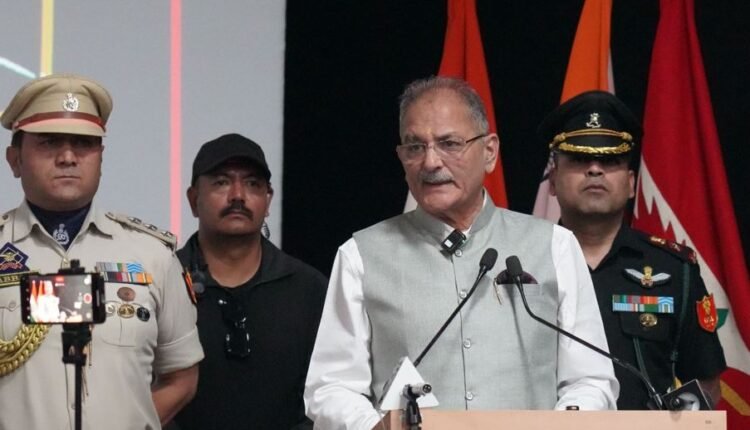Civil–Military Fusion vital for Ladakh’s Development & Security: LG Kavinder
Says Army’s role extends beyond borders to nation-building & civilian support
Leh, August 30: Armed Forces as not only the defenders of India’s borders but also as true nation-builders who have consistently stood with people in times of need—whether in building critical infrastructure, responding to natural disasters, or supporting communities in remote and harsh conditions.
This was stated by the Hon’ble Lieutenant Governor of Ladakh, Shri Kavinder Gupta, while addressing the valedictory session of the Civil–Military Fusion Capsule at Shaitan Singh Auditorium, Karu, where he underlined the importance of closer cooperation between the Army, civil administration, and academic institutions for the holistic development of Ladakh.
In the valedictory session, Lt Gen Hitesh Bhalla, GOC 14 Corps; Chief Secretary, UT Ladakh, Dr Pawan Kotwal; DGP Ladakh, Dr S.D Singh Jamwal; Executive Councillor, LAHDC Leh, Stanzin Chosphel; Administrative Secretaries- Bhanu Prabha, Rudra Goud P.T; DC Leh, Romil Singh and SSP Leh Shruti Arora along with Army and UT Administration personnel were present.
The Lt Governor commended the joint initiative of the defence establishment and the civil administration in organising the interaction programme, describing it as a forward-looking model of teamwork. He said that the Civil–Military Fusion Capsule reflects a shared commitment to nation-building, where the strength of the Armed Forces and the vision of civil society come together to ensure both security and progress.
Shri Kavinder Gupta said that the idea of Civil–Military Fusion is not optional but essential for India’s growth, particularly in Ladakh, where the geography is unique, the environment fragile, and the security challenges significant. He emphasised that the Army in Ladakh has always played a role beyond guarding the borders—acting as the first responder in calamities, a partner in development, and a source of strength for the people in remote villages. At the same time, the civil administration has been leading renewable energy projects, education reforms, healthcare initiatives, and eco-tourism efforts that complement the Army’s contribution, he said.
The Lt Governor asserted that together, the Army and civil administration form two engines of progress—one ensuring security, the other ensuring development. He also stressed the need to institutionalise such cooperation through regular joint exercises, structured platforms for dialogue, and capacity-building initiatives. He called for innovation and modern technology—including renewable energy, drones, telemedicine, and climate monitoring—to be adopted in Ladakh to serve both national security and local communities. He added that all efforts must keep sustainability at their core to protect Ladakh’s delicate ecosystem while ensuring rapid growth.
Concluding his address, Shri Kavinder Gupta said that the Civil–Military Fusion Capsule is not merely an event but the beginning of a mission to make Ladakh a model for balanced development in border areas. “Ladakh must emerge as an example where the strength of the Army and the energy of civil society come together to build a secure, prosperous, and self-reliant future,” he remarked, urging all stakeholders to carry forward this spirit of partnership.
The Lt Governor also felicitated the speakers and panelists who took part in the five-day event.
Earlier, Chief Secretary Dr. Pawan Kotwal gave a detailed presentation on Vibrant Village Programme Phases I & II, stressing its role in reversing migration in Eastern Ladakh by creating livelihood opportunities through tourism, cultural heritage promotion, skill development and entrepreneurship. He also underlined the need to improve living conditions in border areas to encourage villagers to stay, and called for an institutionalised mechanism for regular Military–Civil Administration meetings to address issues of land, law and order.
GOC, 3 Infantry Division, Maj Gen Arindham Saha, in his presentation, highlighted the role of the Indian Army in nation-building in Ladakh.
Similarly, Brigadier Sachin Gehlawat, Commander 3 Army Brigade, gave an update on the Military Civil Fusion Capsule seminar aimed at addressing Army–Civil Administration issues and enhancing border infrastructure, communication, and tourism for Ladakh’s economic growth. He outlined key outcomes, including Army’s role in promoting tourism, dual use of infrastructure, education development, welfare of veterans, community upliftment, forward area development, benefits under Operation Sadbhavana, and the proposal for its annual conduct.
GOC 14 Corps, Lt Gen Hitesh Bhalla, in his vote of thanks, highlighted initiatives taken by the Army to address issues such as stray dogs and sustenance of military personnel. He stressed the importance of strengthening Military–Civil Administration cooperation for building a resilient future for Ladakh and the nation.




